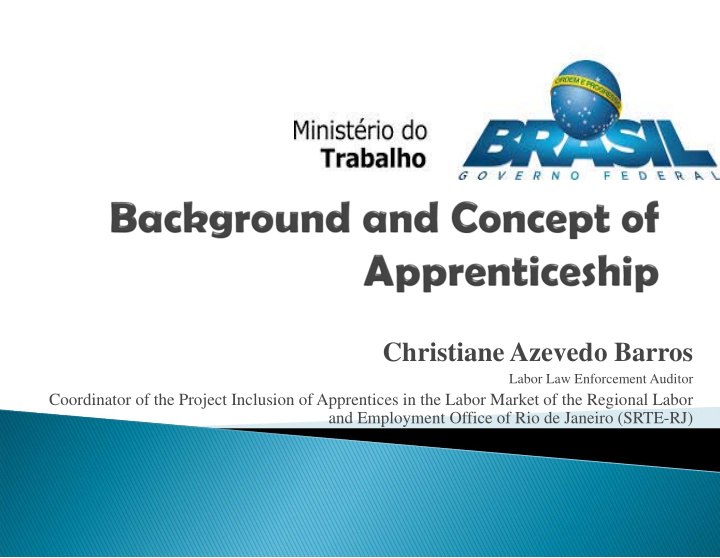



Christiane Azevedo Barros Labor Law Enforcement Auditor Coordinator of the Project Inclusion of Apprentices in the Labor Market of the Regional Labor and Employment Office of Rio de Janeiro (SRTE-RJ)
The The initial nitial landmark landmark of of protective protective laws laws was was precisely precisely the he Industrial Industrial Revolution, Revolution, when hen the he issue issue of of labor labor exploitation xploitation reached eached its its peak. eak. The The history istory of of child child labor abor cannot cannot be separated eparated from from appren apprenticeship. ticeship.
The first apprenticeship contracts were signed in ancient times, in the craft guilds. Under that model, workers joined a craft guild for the purpose of learning something. It was a very different model than the one provided for in the Brazilian law. It was based on the idea of LEARNING BY LEARNING BY WORKING WORKING.
DECREE-LAW No. 1,238/1939 - Provides for the creation of professional training courses for workers, making it compulsory for establishments with over 500 employees to offer professional development courses for adults and minors; DECREE-LAW No. 4,048/1942 - Creates the National Apprenticeship Service for Industrial Workers - SENAI, SENAI, which is in charge of organizing and managing apprenticeship schools for industrial workers throughout Brazil. Makes it compulsory for industrial plants to cover the costs of SENAI's schools through monthly payments collected by government and transferred to the National Apprenticeship Service.
Decree-Law No. 5,452/1943 - Consolidated Labor Laws - Created Created the the obligation bligation to hire ire a number of underage workers to be set by SENAI's National Council up to the limit of three percent (3%) of the total number of employers of all categories in service in each establishment. Art. 429 Decree-Law No. 9,853/1946 - Creates the National Commercial Apprenticeship Service - SENAC PROBLE PROBLEM: M: Delegating to employers the task of setting the rules for hiring underage workers, both in terms of percentages and of courses. RESULT: RESULT: In many states, underage workers were not hired, and when they were actually hired, their number was insignificant.
Art. 227. It is the duty of the family, society and Government to ensure children, adolescents, and youths, with absolute priority, the rights to life, health, nourishment, education, leisure, vocational training, culture, dignity, respect, liberty and family and community harmony, in addition to safeguarding them against all forms of negligence, discrimination, exploitation, violence, cruelty and oppression. (Wording as amended by Constitutional Amendment No. 65, 2010)
Art. 7 - The following are rights of urban and rural workers, in addition to any others designed to improve their social condition: XXXIII - prohibition of nighttime, dangerous or unhealthy work for those under eighteen years of age, and of any work for those under the age of sixteen, except as an apprentice; (Wording as amended by Constitutional Amendment No. 20 of 1998)
Art. 63. Technical and vocational training shall be provided according to the following principles: I - guaranteed access to and compulsory attendance at a regular school; II - the training activity must be consistent with the stage of development of the adolescents; III - special schedule for the training activities. Art. 65. Labor and social security rights shall be ensured to adolescent apprentices over fourteen years old.
Art. 67. Adolescent workers, apprentices, engaged in family work, attending a technical school, assisted in a government or non-government entity, shall not be allowed to engage in the following types of work: I - in nighttime work between 10:00 p.m. of one day and 05:00 a.m. of the following day; II - in dangerous, unhealthy or arduous work; III - in work carried out in locations that can harm their physical, mental, moral and social development; IV - in work to be carried out at times and places that prevent them from attending school.
Art. 69. Adolescents have the right to vocational training and protection at work, taking into account the following aspects, among others: I - respect for the unique condition of a person in development; II - vocational training suited to the labor market.
Decree 6,481/2008 lists activities and locations prohibited for underage workers under the age of 18, including as apprentices.
Art. 428. An apprenticeship contract is a special work agreement established in writing and for a fixed term in which the employer undertakes to provide adolescents over fourteen (14) and under twenty-four (24) years old enrolled in an apprenticeship program methodical technical and vocational training compatible with their physical, moral and psychological development, and the apprentice undertakes to act with care and diligence in carrying out the tasks necessary for this training.
According to the report 2016 Labour Overview of Latin America and the Caribbean, published in late 2016 by the ILO Regional Office, the unemployment rate in Latin America and the Caribbean hit the mark of 8.1% in 2016, the the highest hest level level in a decade in ecade, in a context of economic downturn that also affected the quality of jobs; For young people, the rate increased by almost 3 percentage points, increasing the average unemployment rate for young people to 18.3%, also the highest one in a decade. Currently, Currently, the the unempl nemployment yment rate ate for or young young people eople is 3.1 .1 times times higher igher than han that hat for or adults adults over over 25 25 years years old. ld.
Low schooling, lack of vocational training and work experience. LEARNING LEARNING
Training + Work
It is a special labor agreement in writing and for a specified period of up to two years under which employees are provided with methodical technical and vocational training involving theoretical and practical stages established in an apprenticeship program designed by entities specializing in training and under their responsibility.
Training entity Apprenticeship Em ployee Em ployer
Work + vocational training; Obligation to hire provided for in the law; Fixed period of up to two years; Reduced working hours;
APPRENTICESHIP IS MUCH MORE THAN VOCATIONAL TRAINING
Recommend
More recommend